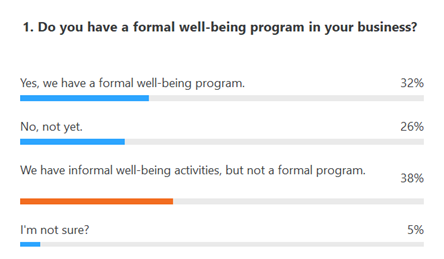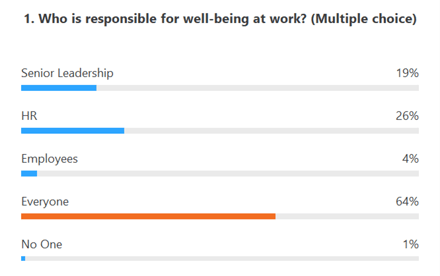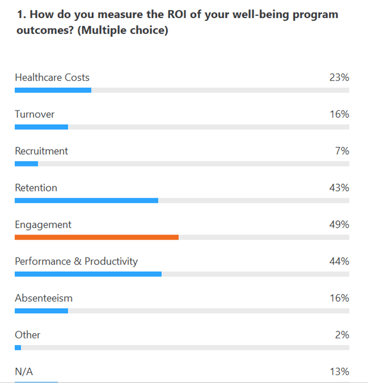By: Cassee Ger on May 5th, 2021
Well-Being @ Work: Key to Employee Engagement & Business Sustainability
On Friday, April 30, Helios HR hosted a webinar to discuss impactful programs that help you nurture a sustainable workforce and culture of well-being at work. Moderated by Helios HR’s President, Ethan Gill, our panel speakers included:
- Taylor Adams, Director of Workplace Mental Health, Mental Health America
- Denise Crute, Director of Training and Development, IQ Solutions
- Ginnette Quesada-Kunkel, Executive Vice President & Chief Human Resources Officer, NFP
- Nicki Salcedo, Vice President, Client Strategy, Optum Behavioral Health
 One of the first poll questions asked to the audience over nearly 100 employers was, “Do you have a formal well-being program in your business?” The majority, 38%, said they “have informal well-being activities, but not a formal program.“
One of the first poll questions asked to the audience over nearly 100 employers was, “Do you have a formal well-being program in your business?” The majority, 38%, said they “have informal well-being activities, but not a formal program.“
The data is not surprising. For years, we have traditionally seen more employers focus on physical health benefits and controlling health care costs. Common things like gym reimbursements, health screenings, weight loss programs, or walking competitions are offered. With a holistic well-being program, employers make an intentional effort to incorporate all aspects of their employee’s lives including the physical, financial, mental, and emotional components that impact their ability to thrive.
If you were not able to attend the webinar and are looking to learn more, here is a copy of the recording and the key takeaways below.
Mental Health is at the Forefront
What most of us know is that mental health isn’t a new issue, and prior to the pandemic, behavioral health was an increasing concern for many employers with an estimated 1 in 5 adults living with a mental illness in the United States. And after the year we all just had, the need to incorporate mental health into your well-being programs has exacerbated and accelerated.
CNBC reported in February 2021, nearly half of U.S. workers suffer from mental health issues since the Covid-19 pandemic hit.
According to Mental Health America, the number of people looking for help with anxiety and depression has skyrocketed from January to September 2020:
- 315,220 people took the anxiety screen available on the Mental Health America website, which is a 93% increase over the 2019 total number of anxiety screens.
- 534,784 people took the depression screen, a 62% increase over the 2019 total number of depression screens.
From racial trauma, loneliness and isolation, shift in work-life balance, school closings, grief caused by the pandemic, etc. all of these factors have contributed to the dramatic rise in mental health challenges.
Burnout is escalating because employees have not been able to go on vacation, which is increasing their mental and physical exhaustion. It’s not just the lack of a vacation. Due to the remote work, employees find it harder to disconnect because their home has become their office, and it’s often hard to distinguish the difference. Monster found in a recent survey that 69% of remote employees have burnout symptoms. Additionally, the increase of childcare responsibilities in 2020 had a ripple effect with women leaving the workforce in the masses, four times more than men, because of exhaustion and stress.
Why Should Employers Care?
There are many reasons an employer should care about their employee’s mental health. First and foremost, it’s just the right thing to do. Secondly, the well-being of your employees will have a direct impact on your business’s bottom line, so it is beneficial to your business to care about your employee’s well-being.
Gallup has found that employees who experience high levels of burnout are 63% more likely to take a sick day and 2.6 times as likely to be actively seeking a different job.
When employees feel like they have to always be “on”, have increased responsibilities with a lack of flexibility and support from their managers, or worry that their performance is negatively impacted because of what they may be struggling with, it creates a ripple effect of problems. In addition to turnover, poor well-being can impact an employee’s productivity, engagement, and can increase their absenteeism rate.
According to the CDC, productivity losses from absenteeism cost U.S. employers $225.8 billion annually or $1,685 per employee and equate to about 217 million days lost.
Recognizing the Need for Help
Another interesting data point is 95% of employees take time off due to mental health issues, but site another reason because of the social stigma, according to the American Psychiatric Association. For years, employers have incorporated aspects of well-being such as physical health, financial health, intellectual development, community impact, and social activities. However, when it comes to the conversation of mental well-being, it is rarely a dialogue at work. Some employees may feel that their employers aren’t providing a safe environment to discuss mental health challenges.
In addition to overcoming the stigma and creating a safe environment for mental health, the panelists shared that the top challenges tend to be:
- Recognizing the signs and symptoms of mental health conditions
- Navigating mental health benefits can be confusing and complicated
- Employees tend to go to the internet instead of a provider before deciding to seek professional help
- Employees are struggling to access care
In response to mental health issues in the workplace, most employers will refer their employees to an EAP (employee assistance program). EAP programs are a great start, and it’s often not enough. Most EAP programs will offer free counseling, and those counseling sessions are usually limited in the number of counseling an employee can receive. EAP programs are great for the short-term, but many employees need more long-term consistent care.
According to NFP’s 2020 US Benefits Trends Report, “Even if an employer wants to provide additional resources to employees, the biggest challenge they face is that demand heavily outweighs the current supply. Most behavioral health specialty solutions still don’t serve the small-to-mid-size market. Given this gap, we expect to see growth in mental health startups (new and existing) to help address these demands.”
Because of the increased demand, many providers are offering digital and virtual solutions to make it more flexible and convenient for employees seeking care. Some of the online tools the panelists suggested included:
- Self-Evaluation Screenings: MHA provides free anonymous online screenings for nine mental health conditions including depression, anxiety, bipolar, PTSD, psychosis, addiction, eating disorders, and a screen for parents and youth. After screening, people have access to education, DIY tools, treatment information, and other services online. Additionally, MHA offers a stress screen for employees to self-evaluate their levels of stress.
- On-Demand Therapy & Support: Sanvello is an in-the-moment app for help with stress, anxiety, and depression. Talkspace offers people the ability to connect virtually with a licensed, in-network provider via unlimited text messaging and real-time audio/video appointments.
- Educational Videos: PsychHub provides a variety of free short videos on mental health. NFP has a Virtual Well-Being Master Class and several trainings available within their Well-Being Fitness Center.
How Employers Can Take Action
So, how do you over the come the mental health challenges? Here are a few tips provided by the panelists that you can use to take bold action:
1) Support and encouragement from leadership
For any well-being program to be successful, it must be supported and encouraged by senior leadership. If you are a leader, you may want to go beyond just funding and supporting a well-being program. Show that you are vulnerable. The pandemic has impacted everyone either on a physical, social, or well-being level and showing vulnerability is a great way to build a connection with your employees.
2) Train Managers
Managers are often the first person an employee may come to for help. Managers often see things happening but don’t know what to do. Train your managers to recognize the signs and symptoms of an employee who may be experiencing a mental health illness. Prepare your managers with guidelines and tools to respond to these types of conversations with their employees.
3) Listen and understand what your employee’s well-being needs are
Understanding what your employees need from a well-being perspective is the first step. Don’t offer more PTO if your employees are all under an increased deadline at the moment, for example. Do your homework and figure out what would be the most helpful and consider your different employee population groups. You can learn more about what they may need via an employee survey or during regular one-on-one meetings with the employee.
4) Flexibility
The well-being needs for each employee will be different, and maintaining the flexibility to respond to those different needs will be crucial for employers moving forward. There isn’t a one-size-fits-all type of well-being plan, and it may be necessary to prioritize well-being needs based on employee feedback.
5) Provide a safe space for open conversation
Employers can remove the stigma surrounding mental health by starting the conversation, being open and honest, and sharing resources on the topic. Optum recommended leveraging lunch and learns to educate and inform your team on mental health. IQ Solutions developed a series called “Building Resilience” to address the various concerns and challenges employees shared that they have been facing over the past year.
6) Leverage partnerships with your benefits providers
 It should not solely be the responsibility of the executive team or human resources to be the authority on well-being. More than half of the respondents agreed that everyone in an organization is responsible. Employers can leverage partnerships with their health care providers, benefits brokers, or other well-being vendors and experts to increase education and awareness and provide resources to help tackle navigation around the mental health systems for easier access to mental health care.
It should not solely be the responsibility of the executive team or human resources to be the authority on well-being. More than half of the respondents agreed that everyone in an organization is responsible. Employers can leverage partnerships with their health care providers, benefits brokers, or other well-being vendors and experts to increase education and awareness and provide resources to help tackle navigation around the mental health systems for easier access to mental health care.
7) Emphasize the social connection
As employers are considering the next steps for their office re-opening plans, this can create heightened anxiety for employees. Concerns of health and safety in addition to social anxiety of re-entering the workforce again. Start finding ways for your team to reconnect to ease the transition as best as possible.
The Key to Sustainable Well-Being Success
The panelists shared what they believed to be the most important steps a leader can do to set up their team for sustainable well-being success is:
- Make well-being a top priority. Don’t let mental health slip as we start to return to the office or allow other priorities to take over.
- Stay in touch with employees and create a safe space to have well-being discussions and opportunities to connect and build relationships.
- Remove the mental health stigma.
- Become an expert about recognizing the symptoms of mental health illnesses.
- Keep an open mind, and don’t assume you have all the answers.
There are many free resources to employers to help guide a sustainable culture of promoting, encouraging, and sustaining a well-being program, and a great place to start as leveraging your partnership with your current benefits or well-being providers. Most providers have access to free resources and educational information for employers and employees. MHA also has a wealth of resources available for employers, from research to providing the Bell Seal for Workplace Mental Health employer certification.
 Lastly, May is Mental Health Month. It’s a perfect time to begin embarking on this journey to drive awareness and show that you are an empathetic and caring employer invested in your people. When you demonstrate these actions, you will be able to measure your success with employee retention, engagement, and overall business performance. It’s the right thing to do and you can start today. For help on creating a well-being program or additional resources to navigate this within your business, reach out to us. We’d be happy to help you get started on your focus on well-being at work.
Lastly, May is Mental Health Month. It’s a perfect time to begin embarking on this journey to drive awareness and show that you are an empathetic and caring employer invested in your people. When you demonstrate these actions, you will be able to measure your success with employee retention, engagement, and overall business performance. It’s the right thing to do and you can start today. For help on creating a well-being program or additional resources to navigate this within your business, reach out to us. We’d be happy to help you get started on your focus on well-being at work.





